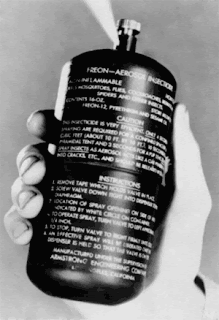 A highlighted quote in PMP magazine's Buzz Online caught my eye today. Alexis Barbarin is a graduate student at Penn State University studying bed bugs and their effects on low income households. Speaking of her insect study subjects, she noted that,
A highlighted quote in PMP magazine's Buzz Online caught my eye today. Alexis Barbarin is a graduate student at Penn State University studying bed bugs and their effects on low income households. Speaking of her insect study subjects, she noted that,"If you set off a bomb in your room, [the bedbugs will] just move to your neighbors' rooms. It's like date night for them."
Alex's colorful simile underscores one of the common mis-perceptions of what many people refer to as "bug bombs." The warlike term, bug bomb, does have military origins. In 1943, two Americans, Lyle Goodhue and William Sullivan, designed the refillable spray can that became the ancestor of today's household bug bombs. Goodhue's and Sullivan's portable can enabled soldiers to spray the insides of their tents for malaria-carrying mosquitoes in the Pacific during World War II. Perhaps with the marketing assistance of Raid® television commercials, people today tend to think of bug bombs (or more accurately, "total release aerosols") as the ultimate in pest control, with an almost uncanny ability to search-and-destroy.
While consumer aerosol generators may flush some insects from shallow hiding places into the open, they are in no way magical in their killing action. Aerosols are most effective at killing flying, or crawling insects on exposed surfaces. Insects inside walls, furniture or even deep in carpet pile are not well controlled with these devices.
The chemicals in aerosol generators are generally short-lived, remain airborne for a limited time and must be carried on air currents if they are to reach into corners and hidden areas in a room. It is unlikely that typical bug bomb products flush and kill many pests who are well protected in furniture, mattresses, behind baseboards and even picture frames, per Alex's bed bug observation. Because of the repellent nature of some of the active ingredients in aerosol generators, if anything insects are likely to be driven deeper into their hiding places or into adjacent rooms, businesses or apartments.
To address another misconception, aerosols are completely different from fumigation. Fumigation involves using a toxic gas, like methyl bromide or sulfuryl flouride, to penetrate food products, buildings or furniture to kill hidden pests. In contrast to fumigants, aerosols consist of very tiny liquid particles that are dispersed into the air via pressurized gas, combustion, or mechanical dispersion. Typical aerosol particles range from 5 to 50 microns in diameter (a typical human hair, by comparison, is approximately 100 microns in diameter). Fumigants, on the other hand, consist of molecules so small that they easily penetrate many substances, including solid wood.
The term "fumigation" should never be used by a professional to mean the same as "spraying" or using a bug bomb. Fumigation is a highly specialized branch of pest control that requires a special license and highly specialized skill and training to perform. Fumigation typically takes place in structures, boats or vehicles that are taped and/or draped with special gas tight tarps.
Another type of application used commonly in pest control is the ULV, or ultra-low volume application. Commercial ULV applicators, like the Actisol and Whitmire Micro-Gen generators, produce particle sizes in the 0.1 to 5 micron range, and are useful for treating voids and cracks not easily reached by sprays or crack and crevice aerosols. Hollow legs of kitchen equipment and voids above ceilings and in walls are excellent places to use ULVs. To avoid problems with repellency, research is being conducted today with low-repellency insecticides in ULV applicators.
Pest management professionals should be aware of the uses and limitations of aerosol and ultra-low-volume applications. Neither are panaceas for tough insect problems. Both should be used in combination with other sanitary and mechanical control methods. And special care should be used to place them directly into pest hiding areas. We want to avoid sending pests on a free date night in the next apartment or business.
3 comments:
Thanks for this post. We often tell people bug bombs are not a good idea for treating bed bugs, but it's not a well-publicized fact in the popular media.
This aerosol fogger is being labeled marketed for bed bugs:
http://www.hotshotbrand.com/ProductCategories/IndoorInsecticides/FleaKillerPlusFogger/
I'm assuming you'd consider it a bug bomb and a bad idea for treating bed bugs, is this correct?
Hi Mike,
Great Blog, I liked the Bombs Away. I'm a pest professional in Gilbert, AZ and would like to link that last article to my blog this next week and recommend to my readers your blog. I used to work for FMC and have met you before. Great work and let me know please, thanks
Keith V. Birkemeyer
ProBest Pest Management
www.callprobest.com
Responding to nobugs, I wouldn't say that using a bomb is a bad idea, it's just not sufficient to solve a bed bug problem. I've seen situations where a total release aerosol might be helpful-where many of the bed bugs were hiding in shallow crevices in the ceiling or in wall texture. And because consumers have very few good control options, a bomb might make some diffence. But I doubt whether a consumer or PMP will ever eliminate a bed bug infestation with a bug bomb unless other measures are taken as well (caulking, treating mattresses and box springs, perhaps bed bug traps, etc.).
Post a Comment